GETTING WATER IN THE NOSE WHILE SWIMMING (HOW TO PLUG YOUR NOSE, SO YOU DO NOT CHOKE ON WATER?) - PART 1
How to Stop Water from Going Up Your Nose When Swimming
The efficient movement of our bodies in the water while swimming does not come naturally to most people. But splashing around with your face in the water? That's as common as sliced bread.
For many, holding your breath underwater is second nature. But for others, the second their head dips below the surface, it's water-up-the-nose panic mode unless they hold their nose or wear a nose plug.
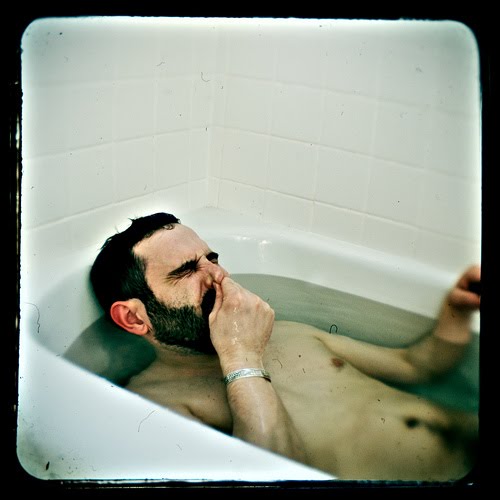
If that's you, keep reading. You're about to learn how to kick this problem for good.
Quick Jump To:
- Why does water go up your nose when swimming?
- What part of the body blocks water from entering your nose?
- How to learn to close your nose using consonants
- Step-by-step: Nose plugging practice in water
- 🎥 Watch this underwater example
- Advanced tip: The human nose clip technique
- What if nothing works? Alternatives to nose plugging
- Conclusion: From Nose Panic to Nose Pro
Why does water go up your nose when swimming?
If you're not able to close off your nasal passage, water will happily travel right up your nose the second your face hits the water. It's all about pressure, the water outside your body is pressing in, and there's nothing in your nose to stop it.
To make matters worse, many people breathe in through both their nose and mouth after resurfacing, even if their nose is already waterlogged. That's not exactly a recipe for comfort.
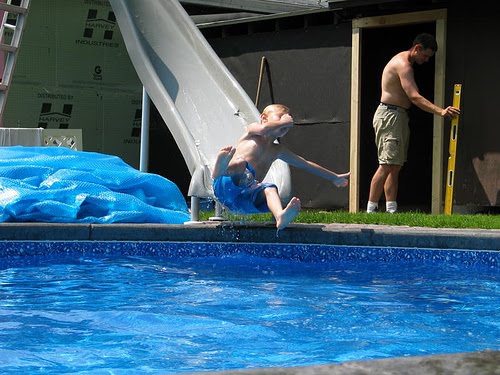
The good news? You're not broken. You just need to learn how to activate a small but mighty muscle.
What part of the body blocks water from entering your nose?
Meet your soft palate, also known as the velum. It's a movable part of the roof of your mouth, located toward the back of your throat. When you lift it, it seals off the nasal cavity from the oral cavity, and voilà, no water up your nose.
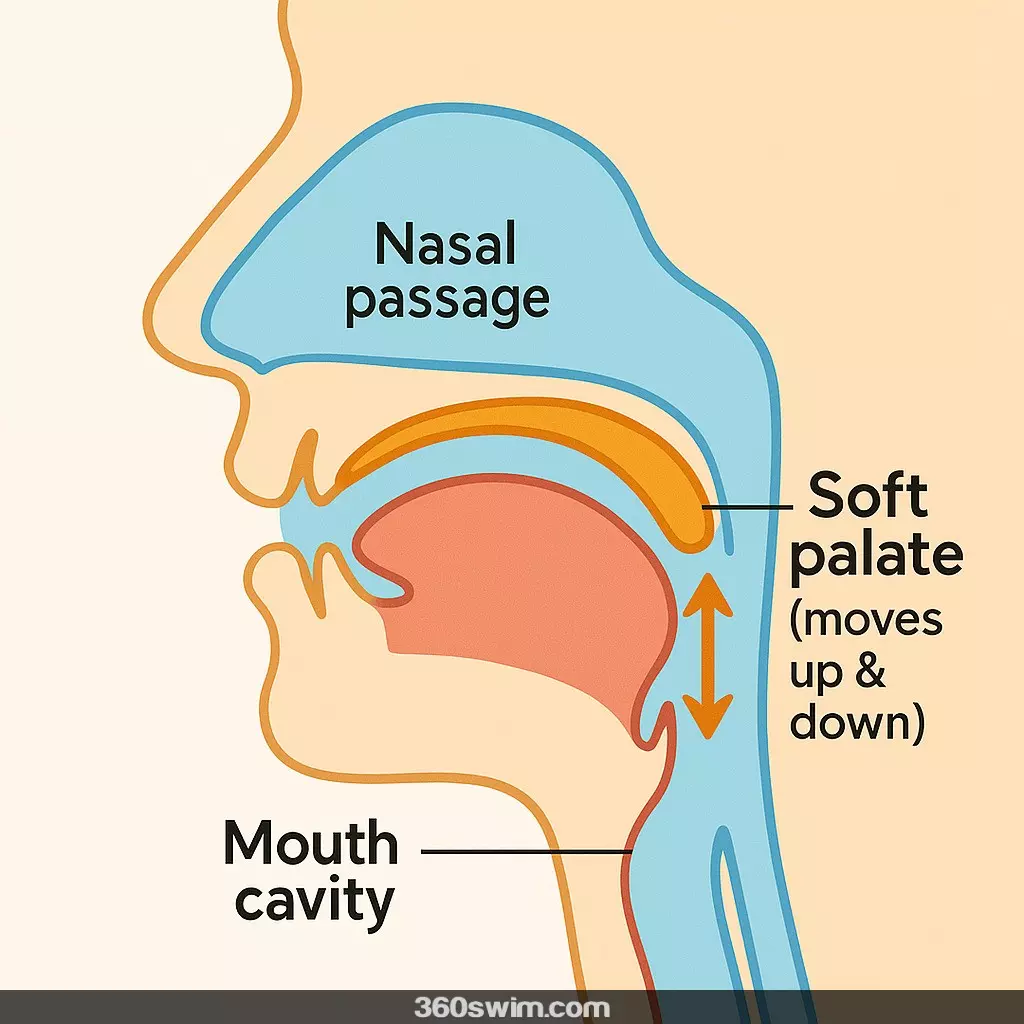
You already use this muscle when you swallow food or pronounce certain letters. Now it's time to make it work for you in the water.
How to learn to close your nose using consonants
Here's a fun way to feel your soft palate in action, no goggles required.
Try saying the word "swimming", and pay attention to where your tongue lands on the "ng" sound. That contact point? That's the soft palate.
Now, try this:
- Say "swim" and freeze at the "M". You'll notice air escapes through your nose, that's a nasal stop.
- Now say "kick", but freeze on the "K". Air only escapes through your mouth. Your soft palate just blocked your nose, success!
These types of letters are called stop consonants. The ones that block the nose are oral stops (K, T, P). The ones that keep the nose open are nasal stops (M, N).
Practice saying these sounds, then mimic that same feeling when underwater. You'll train your body to close the nose subconsciously.
Feel free to use a mirror to check out what is happening in your mouth.
Step-by-step: Practice in Water
Here's how to put your newfound soft palate skills into practice:
-
Start dry
Practice holding the "K" sound out of the water while gently exhaling through your mouth. You should feel your nose is sealed. -
Go shallow
Stand in shallow water. Submerge your face while holding the "K" feeling. Come up. Breathe in only through your mouth. -
Try bobbing
Submerge for 5 seconds while holding the oral stop. Come up, take a quick mouth-only breath, and go back down. Repeat rhythmically. -
Add movement
Once you're comfy bobbing, practice slow swimming with the same soft palate awareness. You're retraining your breathing patterns and nasal control together.
🎥 Watch this underwater example
In this video, you'll see a swimmer demonstrating perfect soft palate control: mouth opens underwater, water flows in, but no panic, just gentle air bubbles escaping through the nose. This is the relaxed state we're aiming for. You'll notice there's no nose plug needed, no holding the nose, just comfort and control.
Be patient, this may take a few days or even weeks. But once your body "gets it," you'll never look back.
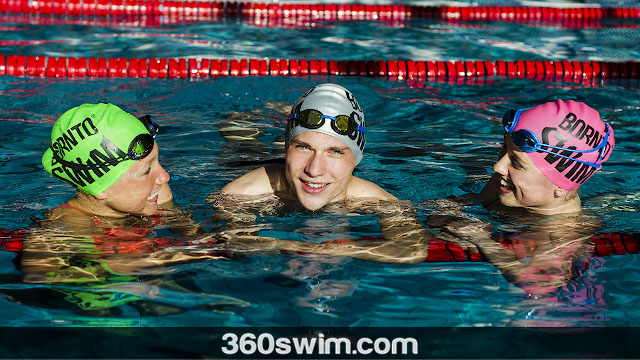
Advanced tip: The human nose clip technique
Once you're comfortable, you can try the human nose clip technique.
It's a method of manually sealing your nasal passage by adjusting the position of your lip, nose, and cheeks. Some swimmers master it to the point they can hold water out simply by flexing their facial muscles.
Want to learn more? Check out my full post on The Human Nose Clip.
What if nothing works? Alternatives to nose plugging
Still struggling even after practice? You're not alone. Here are some options:
-
Nose plugs
Not ideal for freestyle or breaststroke, but useful for beginners or for backstroke competition to avoid losing air during underwater kicks. -
Scuba mask that covers the nose
A larger goggle-like mask can be a great option for casual swimmers who just want to avoid the discomfort altogether. But it is not a solution, just a band aid to the problem.
Just don't give up before giving your soft palate and consonant practice a real shot!
Conclusion: From Nose Panic to Nose Pro
Whether you're tired of holding your nose or just want to swim with more freedom, learning to control your soft palate is the key.
To recap:
- Understand why water enters your nose
- Learn to feel and engage the soft palate
- Practice with oral stop consonants
- Try step-by-step underwater drills
- Experiment with advanced techniques like the human nose clip
- If needed, use external gear as a last resort
Most importantly: stick with it. Just like learning to float or blow bubbles, this is a skill. With a bit of practice (and some silly "K" sounds), you'll be a nose-plug-free swimmer in no time.
Frequently Asked Questions
Why does water go up my nose when I swim?
Water enters your nose due to pressure differences and an open nasal passage. If your soft palate is not blocking the nasal cavity, water flows in freely when submerged.
How do I stop water from going up my nose without a nose plug?
You can learn to block your nasal passage by engaging your soft palate. Practicing consonant sounds like "K", "T", and "P" helps train the muscles to seal the nose internally.
What is the soft palate and how does it help in swimming?
The soft palate is a muscular flap at the back of the mouth that separates the oral and nasal cavities. When engaged correctly, it prevents water from entering the nose while underwater.
Should beginners use a nose plug?
Nose plugs can be helpful temporarily, but they are not a long-term solution for strokes like freestyle or breaststroke. Learning to use your soft palate is a better and more natural option.
Is it normal to struggle with water going up the nose?
Yes. Many beginners find it difficult at first, but with the right techniques and practice, it becomes easy to swim without nose plugs.
What is the human nose clip technique?
It is a self-learned technique using muscular control and head positioning to block water from entering the nose, without relying on external nose plugs. You can learn more about it in part 2 of the article.
Can I use a mask instead of a nose plug?
Yes, using a swim mask that covers your eyes and nose can completely eliminate nose water problems. It is a good alternative for casual swimming or if nasal control is too difficult to master.
Is breathing through the mouth enough to prevent water up the nose?
Not always. You must also actively close the nasal passage using the soft palate. Breathing technique alone may not be sufficient to keep water out, especially underwater.


 LNURL1DP68GURN8GHJ7URP0YHRXD3SWDMKJMFWVDHK6TMVDE6HYMRS9A4HSCNCWFXSH3NN0H
LNURL1DP68GURN8GHJ7URP0YHRXD3SWDMKJMFWVDHK6TMVDE6HYMRS9A4HSCNCWFXSH3NN0H
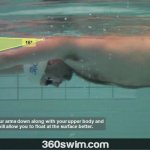

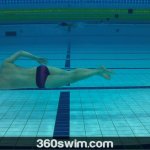
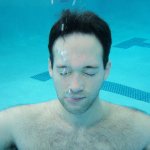
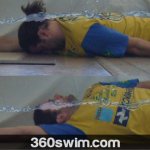
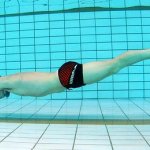

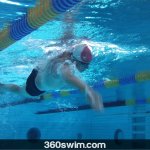
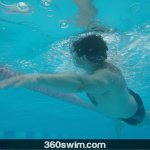

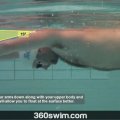

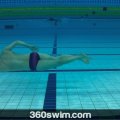
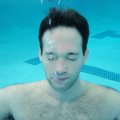
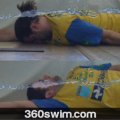
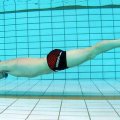

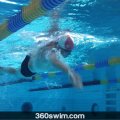
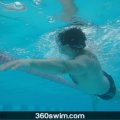

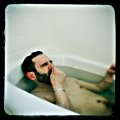
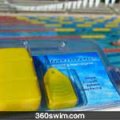
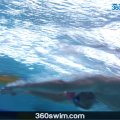

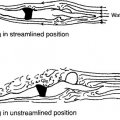
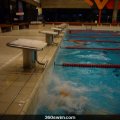
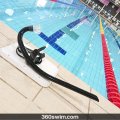
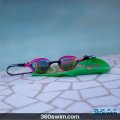
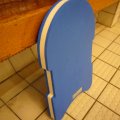


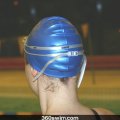
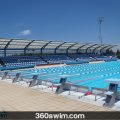
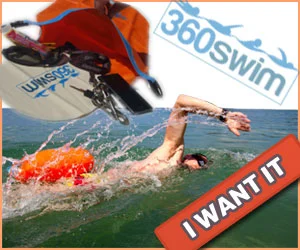

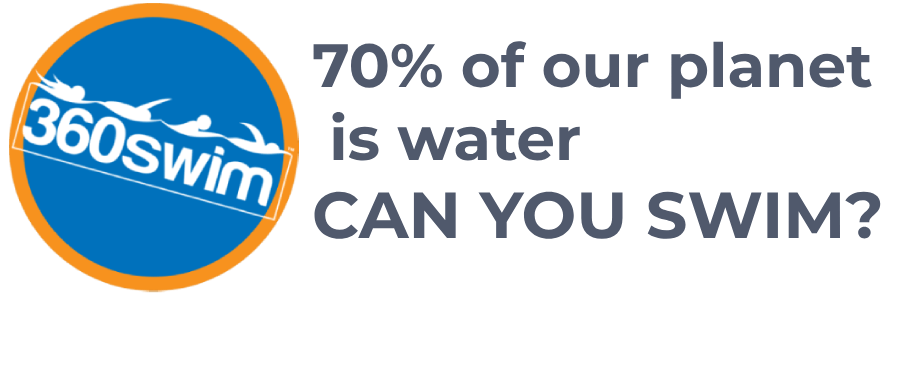

Comments (85)
When being under water is your second nature then you can blow bubbles through both your mouth and nose.
Thanks in advance for your response!
Thanks
When I try to wait just as you said,
I drop into the water before I can take
breath.
I think my real problem is.
I cannot take air into
my lung fast enough.
Can you give me advise.
-Thanks in advance-
::-Heidi-::
1) you metioned 'Is this the only possible way to breathe normally underwater' - well, you don't actually breathe under water, you breathe above the water and always inhale with your mouth (not your nose)
2) when you swim freestyle, you face is down, eyes looking at the bottom of the pool and when you need to take a breath, this is usually when the water enters the nose as you turn your head to the side to take a breath. To help with this, start blowing air through your nose out into the water right before you are about to take a breath. This will create an outward surge of air and no water will come in.
Hope this helped a little. It is hard to give advice without actually being there with your in the pool, but keep going and don't give up, you will eventually get it. Trying different things helps.
If I lay back into the water, facing the surface, I am able to shut my nose cavity off from my throat. But, the cavity still fills with water.
You mentioned to Heidi:
2) when you swim freestyle, you face is down, eyes looking at the bottom of the pool and when you need to take a breath, this is usually when the water enters the nose as you turn your head to the side to take a breath. To help with this, start blowing air through your nose out into the water right before you are about to take a breath. This will create an outward surge of air and no water will come in.
I was under the impression that water was always trying to rush in your nose as your head begins to face the surface as being normal for everyone.
Is that correct? Or should I be working on this technique (or some other technique) that could prevent water entering the nasal cavity as my head turns? Or is this technique just to seal off the nasal cavity water from going down your throat?
You are correct in the statement that when you turn your head upside down (facing up towards the ceiling) water will always rush in.
The nose plugging technique described in this article is mainly for individuals who have hard time keeping water out of the nose while the face is down in the water (facing the bottom). Sounds like you have mastered this.
To Heidi, I was explaining what to do during the transition period between bottom facing and top facing position. Since this transition period is short, you can purge air out of your nose to keep the water from flowing in.
For the ceiling facing water into the nose issue, you should use the human nose clip technique - /blog/human-nose-clip-getting-water-up-my-nose
If you have issue of water getting into your nose during a flip turn, you could try the human nose clip technique or just purging air through your nose and that should do the trick.
The next thing I want to try is rotary breathing, and there I hit a snag. When I turn my head sideways out of the water, the water comes in my nose. Sometimes it enters as I'm tipping my head out, and sometimes it enters as I'm tipping my head back in. I'm only turning far enough to get my mouth into the air, and I'm keeping my ear in the water, so it's not that I'm turning toward the ceiling and having it run in that way.
Any idea what I'm doing wrong? Or is there something I need to know to keep the water out while breathing, in addition to the tips on this page? Has anyone else heard of this particular problem?
Thanks!
From what you have described, I would not start learning how to breathe just yet. Breathing skill is very difficult to learn without having a great body balance and control in the water. I'd suggest learning to rotate your body from one side to the other without breathing first.
However, to address your question. When you start rotating your head to breathe, your nose goes from pointing down towards the bottom of the pool to going to the side where you get some water in. During the rotation, you can do a couple of things:
1) blow through your nose during the rotation, this will keep the water out
or
2) try learning to maneuver your upper lip to cover the nostrils which also is a good technique to keep the water out.
Hope this helps.
waiting for your article on holding water while flipping :)
I got here searching in google about a 'problem' I have. I can swim and even dive a bit, as long as my nostrils are more or less downwards, but when some water gets inside my nose I feel an intense pain in my nose and my head. Is that normal?
To plug your nose in those positions, you can try the human nose plug technique to do what you need to. It works for some, not so much for others, so give it a shot. Good luck.
I can dip my face into a sink so that my eyes and chin are underwater and my nose/throat does not fill with water. Is it safe to say that I can control my soft palate adequately?
I'm starting to think that my problem is more psychological than physical.
Great blog by the way! Thanks.
Basically I am happy with my swimming and my breathing, but I just bought myself a new pair of googles and now I notice I have water going up my nose! The googles seem fine, but seriously when I wear them I notice a lot of water going up my nose - so now I'm changing my technique to blow it out. If I go back to my old googles I'm fine. I've noticed my new ones have bigger cups/lens over each eye and I'm wondering if the extra air in there - a bigger space - means the water can compact it easier to creep up my nose!! Mad I know... any help appreciated. Darren
and start to hyperventilate. We have no idea why I do this and my teacher is at a loss to help me. I still love being in the water but this problem is holding me back. Any ideas please?
Cheryll
Your blog post was very helpful, and I'll try these techniques the next time I swim.
Thanks!
Going swimming again tonight and since this comment is moderated i'll probably be swimming by the time its posted. So answers wont help me, just pointing out the article can be confusing. 'Holding the K constant,' do I keep saying 'Kay' over and over again? As that seems to be the only alternative to holding my tongue in the K position and trying to breathe (impossible).
Thank you,
On the other hand, if the issue is about inhaling, then there is no need to say any letters. Just simply deeply inhale, so your chest rises.
Hope this helped. Anything else, just ask.
PS: Unfortunately, I have to moderate the comments. Too many crazy spammers out there.
Just wanted to say thank you! After 4 months struggling to learn how to breathe while swimming, I think I finally got it, thanks to this post.
As French is my mother tongue, I first looked for info on the Internet in this language, but couldn't find any actual solution to my problem (other than 'just blow through your mouth' or 'wear a nose clip').
I practised the technique you suggest for quite some time in the shallow water, staying still, and then, when I felt I got it, tried while swimming. It didn't work right away, but the week after, I could, for the very first time, swim from one end of the olympic pool to the other without stopping to cough or catch my breath. Also, maybe this is obvious to some people, but I found it helped to really face the bottom of the pool while exhaling. And I usually hold my breath or finish emptying my lungs through my nose when I lift my head again. Not sure what a swimming coach or a professional would think about that, but I can really swim a long time this way, which I think is a good sign.
Anyway, I think the ideal breath cycle is different for each person and can take a while to figure out, but it's worth the effort. :)
After reading this, I started practicing, and after only a couple of pool visits, I can swim a good 15-20 meters without my head popping up. You've saved me from permanent embarrassment by a seven-year-old. And though I never cared much for swimming before, now I'm actually starting to enjoy it!
I learnt swimming 13years ago but I avoided learning freestyle as I hate the water entering my nose. I do swim but never swim freestyle.
However, in April, I wanted to overcome my dislike towards freestyle, so I start learning again. Same thing happen still, water keep entering my nose when I reach to the suface for taking breath. I always need to stop, not because of feeling tired or losing breath but because I cant bear water getting into my lungs.
I came across your blog as I was searching for the reason why water keeps on getting into my nose during freestyle. I guess your article already explain my situation.
Though I dont thoroughly understand the exercises, I will try to practice your suggestion.
Thank you so much.
(Muni)
Thank you so much for this post...but I'm a little confused. I just started learning how to swim about two weeks ago. My last swim lesson, I had to jump in the deep end as somehow I kept getting water in my nose (I wasn't breathing it in) and it would go down my throats and I would choke. I ended up swallowing pool water 4 times this way. Now I am home with a very raw feeling throat and raw feeling, runny nose. I am having so much trouble coordinating my breathing movements while diving, jusmping, flipping, etc. Maybe I just need a TON of practice? I know it's just my second swim lesson but ugh it's awful. I also have a tendency to tense up in the water and freak out a bit. I'm a very cautious, scared type of person. I also probably wouldn't be allowed to wear a nose clip air goggles to cover my nose unfortunately. If anyone has tips for me I'd gladly take them! Thank you for your time!!
Let me start out by saying that I'm 33 years old and have only been able to enjoy the water with a nose/goggle mask all my life. My Dad is an excellent swimmer. He tried to teach me when I was a kid, but only continued to tell me to blow air out of my nose like most people will tell you. This does not and has never worked for me. It probably works for 99% of people, but never for me unfortunately.
All my life I've dreamed of being able to swim and enjoy the water properly. I searched for tips and tricks to try again as an adult and found this site. I never heard about the soft palate trick, blocking with the tongue position by holding the 'k' sound in stick, for instance. Let me tell you that I was hopeless. Even putting my face towards the shower water and it would shoot up my nose and down my throat.
But guess what... THIS TRICK WORKS. It takes practice, but it works. I was in the pool and not only was able to put my face in the water, I was able to sit down underneath, head facing forward and down with my eyes towards the floor and a minimal amount of water got in. It was no where near as uncomfortable as I remembered from my childhood. I would have a sore throat for hours if I slipped under the surface as a child that's how much water would rush in and down my throat. Now? Even when a bit slips in (due to lack of practice I'd assume) it's so minimal and the discomfort has only lasted me 5 minutes at most (one time and I think I did it wrong that time). It's not painful like it used to be. And the longer I'm in the water the more confident I become until I'm going under and pushing off the wall and coming up in a good 5 seconds. A LONG time for someone like me!
I've only been in the pool and tried this two times since and that's a lot of progress already for me. I told myself to remember to come back to this page and thank you personally, as I never thought in my life that I'd be even close to where I am now. I have confidence for the first time and hope that I'll be able to swim more and more. Thank you!! I feel like I've grown wings and can fly, that's how happy this has made me.